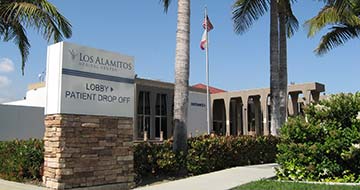By John Underwood
In this past year of pandemic, Orange County alone has experienced over 5,000 deaths resulting from Covid-19, five times the average seasonal flu mortality rates. Over 250,000 plus symptomatic cases resulted in hospitalization, skilled nursing facility care or some form of quarantined isolation. Most of these individuals over the past year endured, or succumbed, to Covid-19 deprived of the comforting support or vigilant advocacy of family or friends.
Beyond the accounting of costs the pandemic has imposed on our population as a whole, we are only beginning to account for the personal damages that have accrued as a result of the isolation and separation of patients from their loved ones particularly in the hospital setting where strict ‘no visitation’ policies have been in place for almost the entire duration of this pandemic.
This emotional toll of separation, suffered in silence by most who have been hospitalized and isolated during this pandemic, can be as damaging and as heartbreaking for the patients and their families as the more gruesome and well described course of the disease itself.
The imposition of blanket ‘no visitor’ policies by hospital systems in Orange County and across the state beginning in March of 2020 were certainly an understandable precaution, supported by CDC and California Department of Public Health guidelines. Particularly in the early months, when the novel coronavirus was a largely unknown entity rapidly spreading, hospitals took the unprecedented step of closing their doors to outside visitors almost entirely.
Since then, the Centers for Disease Control have established tested guidelines for effectively reducing the spread of the virus in institutional settings and established the value of mask wearing and other personal protective precautions. Hospital staffs have implemented those guidelines to great effect. And now with the availability of vaccines as an additional layer of protection for the inoculated and those they come into contact with, reasonable protections for patients and staff can be assured, and those hospital doors are beginning to open again across OC for those who wish to visit their loved ones and attend to them inside the hospital setting for the first time in a year.
The first hospital in OC to resume visitor privileges was UCI Medical Center in Orange. A teaching hospital and a Trauma 1 emergency center, UCI Medical Center sets the standard in many ways for other hospital systems. In March of this year UCI was the first to allow two visitors a day, one at a time, for short periods of time, now expanded to two at a time for visits of any length from 11AM to 6PM. Visitation with Covid patients is still by video chat only. Other hospitals have followed with similar visitor policies, all of which closely shadow CDC and CDPH guidelines. But hospital administrators are quick to point out that each hospital ultimately determines access requirements and the conditions of visitation based on its own circumstances.
Hoag Hospital in Newport Beach opened its doors to visitors on April 22 from 8:30AM to 6:30PM; two at a time if from same family. Hoag rightfully refers to its visitors as “support persons,” respecting the important role family, friends and patient advocates play in the overall well-being and recovery prospects of the patient. Acute care patient visits, including Covid-19 patients, are handled on a case-by-case basis at Hoag. Children may accompany a parent entering the ER there. Even pets may be allowed if they are service animal certified, Hoag’s website affirms.
Los Alamitos Medical Center which only began loosening its visitation policies on May 3rd now extends to its patient visitors one of the most liberal visitation policies among the 25 hospitals of Orange County with hours extending from 8AM to 8PM. Typically, visitation is limited to one person at a time, no limit of visitors per day, and no particular time limit per visitor. But as LAMC Communications Director Jennifer Bayer told me recently “exceptions are made on a case-by-case basis for visitors of patients with disabilities who require support from family members…or for compassionate care cases. The idea here is to maintain social distancing even in the hospital setting.”
There are varying exceptions to visitation rules at every hospital I contacted, based on the condition of the patient as well as the medical condition of the visitor seeking visitation, whom staff will screen before allowing admittance. These variables are often in flux and any persons contemplating visiting a hospital should call ahead to know what to expect, and what will be expected of them. Hospital visitation policies in OC do vary, and some have yet to open their doors to visitors, generally making exceptions only for end-of-life, postpartum care, or pediatric cases. Most of the county’s medical centers have now adopted relaxed guidelines, though none have yet returned to full pre-pandemic visitation levels.
It should be noted that despite the CDC’s recent relaxing of guidelines on mask wearing among the public at large, NO hospital in the OC area allows the removal of approved masks by any visitor at any time during their visitation. In fact, most hospitals will require visitors to use only an approved hospital mask upon entrance, one they themselves will provide. UCI Med Center’s Communications Director John Murray explains that the maintenance of a strict masking policy at UCI Med Center is actually pursuant to current emergency orders from Cal/OSHA for Aerosol Transmissible Diseases. “With regards to masking, along with other worker protective measures, we follow Cal/ OSHA guidelines to reinforce our masking policies. And so far, those requirements have not changed, anywhere inside our hospitals or clinics,” Murray emphasized.
But the good news is many other areas of hospital visitation policy have now loosened to welcome visitors, incrementally at first, but with every indication the doors will open further in coming days. The long year of Covid has receded and with it the grim stories of patient isolation and lonely deaths for Covid and non-Covid patients alike are diminishing, leaving some hard lessons the pandemic has taught us. One of those lessons is that patients confined to hospital beds deprived of their loved ones and caregivers are less likely to thrive, not as likely to rally back to health, as those who have the benefit of personal contact with visiting family members. The taxing work of hospital nurses and staff who have attended to patients mostly in isolation this past year are to be commended for their professionalism and often for their compassion. But in the last analysis, theirs is the kindness of strangers. Nothing can replace the comfort, the reassurance and the watchful vigilance of loved ones on behalf of the hospitalized patient.
This pandemic has placed us all, in a very real sense, 6 feet apart. And this distancing has no doubt saved lives. But if hospitals have now figured out how to protect the safety of their frontline staff and their workplaces from this pernicious vector called Covid-19, then we surely can apply those protective protocols to a caregiving public when they seek access to their hospitalized loved ones.
They constitute legitimate partners in the recovery of hospital bound patients debilitated by their infirmities and too often incapable of advocating well for themselves. Every visitor of a patient is a potential advocate for better care. Many among staff at hospitals, nurses and doctors understand the bigger role visitors from the outside play in the well-being of patients, and welcome a return of visitors, as does LAMC Hospitalist Dr. Lily Mulroy. “There is significant medical value in having family and friends present with the patient. Patients will respond better to therapies when they have the assurance of family around them.” Dr. Mulroy said she has lived through the heartbreak of patients struggling alone in the hospital. “Every single patient I have seen in the last year suffer or die alone has affected me. No one should be alone in a hospital.”
The public should welcome and embrace the newly renewed opportunity to visit loved ones in our hospitals, respect its limitations at present, and take every advantage of the invitation to support the hospital bound patient in every way possible. Visitation policies are evolving and specific conditions at every hospital are in flux at this time, so be sure to check each hospital website for current visiting restrictions. Every hospital has them. But among the hard lessons learned from this pandemic, certainly in the hospital setting, has been the recognition that, for the patient, those connections to family and friends are the very basis of a healing outcome and need to be maintained. Your local hospitals want you to know their doors are open once again. For now, just be prepared to mask up.
Note: John Underwood is a former editor of the News Enterprise, an independent journalist and a producer for Los Al TV.












